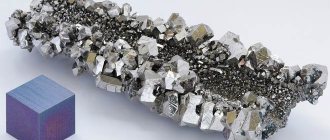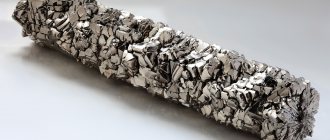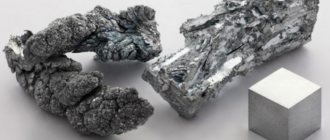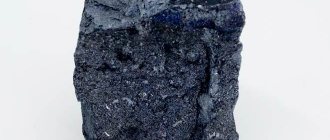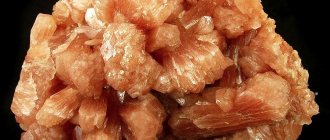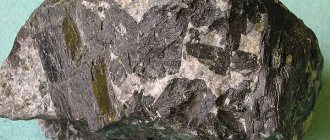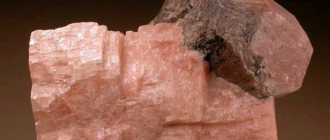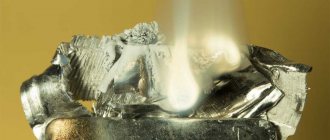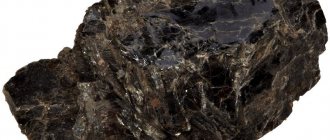- Designation - Mn (Manganese);
- Period - IV;
- Group - 7 (VIIb);
- Atomic mass - 54.938046;
- Atomic number - 25;
- Atomic radius = 127 pm;
- Covalent radius = 117 pm;
- Electron distribution - 1s22s22p63s23p63d54s2;
- melting temperature = 1244°C;
- boiling point = 1962°C;
- Electronegativity (according to Pauling/according to Alpred and Rochow) = 1.55/1.60;
- Oxidation state: +7, +6, +5, +4, +3, +2, +1, 0;
- Density (no.) = 7.21 g/cm3;
- Molar volume = 7.35 cm3/mol.
Manganese compounds:
- Manganese oxide MnO(II)
- Manganese hydroxide Mn(OH)2(II)
- Manganese oxide MnO2(IV)
- Manganese oxide Mn2O7(VII)
- Manganese salts
- Permanganic acid
Pyrolusite (manganese mineral) has been known to people since ancient times; it was used by our ancestors to clarify glass obtained by melting. Until 1774, pyrolusite was considered a type of magnetic iron ore. It was only in 1774 that the Swede K. Scheele realized that pyrolusite contained a metal unknown to science at that time, after which Yu. Gan obtained metallic manganese by heating pyrolusite in a stove with coal. “Manganese” received its name at the beginning of the 19th century (from the German Manganerz - manganese ore).
Manganese ranks 14th among all chemical elements in terms of abundance in the earth's crust. Most manganese is found in basic rocks. Independent deposits of manganese are extremely rare; more often this metal accompanies iron in many of its ores. Quite a lot of manganese is contained in iron-manganese nodules located in the bottom part of the World Ocean.
Minerals rich in manganese:
- pyrolusite – MnO2 nH2O
- manganite - MnO(OH)
- manganese spar - MnCO3
- braunite – 3Mn2O3 MnSiO3
Manganese in D.I. Mendeleev’s Periodic Table of Chemical Elements, numbered “25”, belongs to the transition metals (See Atoms of transition elements).
Rice. Structure of the manganese atom.
The electronic configuration of the manganese atom is 1s22s22p63s23p63d54s2 (see Electronic structure of atoms). In the formation of chemical bonds with other elements, 2 electrons located on the outer 4s level + 5 electrons of the 3d sublevel (7 electrons in total) can participate, therefore, in compounds, manganese can take oxidation states from +7 to +1 (the most common are +7 , +2). Manganese is a reactive metal. Similarly, aluminum at room temperature reacts with oxygen contained in atmospheric air to form a strong protective oxide film that prevents further oxidation of the metal.
Physical properties of manganese:
- silver-white metal;
- solid;
- fragile when n. u.
There are 4 known modifications of manganese: α-form; β-form; γ-form; δ-form.
Up to 710°C, the α-form is stable, which, upon further heating, successively passes through all modifications to the δ-form (1137°C).
Irreplaceable element
From ancient glassblowing to steel production, from fighting oxygen radicals to photosynthesis, manganese has always played a fascinating role in chemistry, geology and biology.
Manganese is a typical metal with atomic number 25, located in group 7 of the periodic table of elements. The generally accepted designation is Mn. The configuration or electronic formula of manganese is [Ar] 3d5 4s2. The structure of the atom consists of a positively charged nucleus (+25) (with 25 protons and 30 neutrons), around which 25 electrons move in four orbits. The presence of five unpaired electrons indicates that in its compounds manganese can have valence from II to VII. The structural (graphical) formula O = Mn = O shows how the atoms are connected to each other inside the molecule.
Being in nature
This metal is an extremely versatile element. It can exist in six different oxidation states, but is never found in nature as a pure element. It is usually found either in its +2 reduced state, which readily dissolves in water, or in its +4 state, forming many more types of insoluble oxides.
The usual production method is by heating manganese dioxide (MnO 2) with carbon or aluminum. Reaction with these elements removes the oxygen and leaves behind pure metal.
The most common ores containing manganese are pyrolusite, manganite, psilomelane and rhodochrosite. The largest suppliers of ore in the world are:
- China.
- South Africa.
- Ukraine.
- Brazil.
- Australia.
- Gabon and Kazakhstan.
This element is also found in abundance on the ocean floor. Scientists estimate that up to 1.5 trillion metric tons of manganese nodules may lie at the bottom of the world's oceans and large lakes. But at present there is no effective way to mine these ores.
Vitamins with manganese
This microelement is present in multivitamin complexes and “solo” versions:
- Vitrum (capsules): Classic – contains 2.5 mg of Mn (average daily value for women); Junior – 1 mg (daily “children’s” value of manganese); Prenatal Forte – 5 mg (standard Mn for pregnant or lactating women).
- Multitabs – 2.5 mg (standard manganese intake for an adult);
- Complivit – 2.5 mg (also “adult” standard);
- Active manganese – 3 mg, tablets; for those who primarily need manganese; also contains microdoses of zinc, vitamins B1 and C; one tablet daily with meals;
- Turamin Manganese – an additional source of Mn for adults and children over 14 years of age; the drug is contraindicated during pregnancy and breastfeeding;
- Bio-Manganese – ) positions the drug as containing Mn in an organic modification that is easily digestible by the body; one tablet provides the daily “adult” need for a microelement (1.25 mg).
History of discovery
Manganese, in the form of the black ore pyrolucite, was used by cavemen in cave paintings about 30,000 years ago. Compounds of this metal were used by the Egyptians and Romans to decolorize glass.
Even in ancient times, excellent ores were discovered in the Magnesia region of Greece. This is where the problem with names began. All minerals coming from this region containing magnesium and manganese came to be called magnesia. Magnetic ironstone discovered in this region was also called Lapis magnis or magnesium stone.
For some time there was a general confusion of names concerning manganese and magnesium, but at the end of the 18th century a group of Swedish chemists led by Thorbern Bergman proved that manganese was a separate substance. In 1774, Scheele, a member of the group, presented these findings to the Stockholm Academy, and later that year Johann Hahn became the first person to obtain the metal from a chemical reaction.
Sources of manganese in foods
Almost all products - animal or plant origin - contain varying concentrations of microelements. But in the latter, the benefits of manganese are maximum.
Mn-rich foods
“Plant” products are leaders in manganese content:
- black or green tea, coffee, cocoa;
- all nuts;
- all legumes;
- vegetables - sweet peppers, beets, carrots, radishes, radishes, white and cauliflower cabbage, garlic;
- garden greens;
- fruits, dried fruits - apricots, figs, kiwi, bananas, pineapples, tropical exotics, prunes;
- all unrefined vegetable oils;
- berries - strawberries, raspberries, cranberries, blackberries, lingonberries, blueberries, black currants;
- mushrooms – porcini, boletus, chanterelles;
- pasta and other durum wheat products;
- cereals – oatmeal, buckwheat, rice, millet; Whole grain cereals are especially useful;
- grain - wheat, rye, oats;
- seasonings – ginger, cloves.
Animal products with manganese:
- offal, especially liver;
- fish, crayfish, crabs;
- dairy products.
However, after heat treatment, manganese in products of animal origin almost disappears. Boiled legumes lose the least trace element, and other vegetables lose a little more. Mn loss is reduced by quick cooking of foods.
Table of contents in products
The content of the trace element Mn (mg) per 100 grams of product is given.
| Legumes, grains | |
| soybeans | 2.8 |
| chickpeas | 2.14 |
| beans | 1.34 |
| lentils | 1.19 |
| peas | 0.72 |
| rye | 2.77 |
| Cereals | |
| oatmeal | 5.08 |
| wheat | 3.81 |
| brown rice | 3.63 |
| buckwheat | 1.56 |
| barley | 1.48 |
| millet, polished | 0.93 |
| Vegetables | |
| beet | 0.66 |
| White cabbage | 0.37 |
| carrot | 0.34 |
| Sweet pepper | 0.21 |
| radish | 0.15 |
| Fruits, berries, dried fruits | |
| a pineapple | 1.46 |
| dried figs | 0.51 |
| prunes | 0.32 |
| apricot | 0.44 |
| blueberry | 0.25 |
| cranberry | 0.23 |
| Garden greens | |
| garlic | 1.67 |
| dill | 1.26 |
| basil | 1.15 |
| spinach | 0.92 |
| salad | 0.55 |
| ginger (root) | 0.23 |
| Nuts, seeds | |
| pistachios | 3.81 |
| pumpkin seeds | 3.32 |
| sunflower seeds | 1.95 |
| walnut | 1.94 |
| almond | 1.93 |
| peanut | 1.93 |
100 g of tea contains 155-880 mg of Mn (depending on the variety).
Application value
Today, manganese is used for countless industrial purposes, the most important of which is steel production. When steel was invented, in 1856, it cracked when hot forged. The problem was solved later that year when Robert Foster Mouchet discovered that adding small amounts of manganese to molten iron solved the issue. Since then, all steel contains this mineral. In fact, about 90% of the manganese produced today is used to make steel.
The most common alloy is ferromanganese. It contains about 48 percent manganese combined with iron and carbon. Ferromanganese is the starting material for the production of a wide variety of steel products, including:
- tools;
- heavy machinery;
- railways;
- bank vaults;
- building components;
- car parts.
Another common alloy is silicomanganese. It contains manganese, silicon and carbon in addition to iron. Used for structural elements and springs.
Manganese is also used to make alloys with metals other than iron or steel. For example, the alloy known as manganin is composed of 84 percent copper, 12 percent manganese and 4 percent nickel. Manganin is used in electrical appliances.
Perhaps the most important commercial use of these compounds is manganese dioxide (MnO2), used to make dry cell batteries used in electronic equipment, flashlights and pagers. Using dioxide in the dry cell prevents hydrogen gas from building up in the battery when generating electricity.
Another compound, manganese chloride (MnCl2), is a feed additive for cows, horses, goats and other livestock. Plant fertilizers also contain manganese chloride.
In medicine, the so-called potassium permanganate (potassium permanganate) is used as an antiseptic, for gargling, cleaning wounds, treating burns and washing the stomach in case of poisoning.
Finally, small amounts of the compounds are used as dyes in bricks, textiles, paints, inks, glass and ceramics. In addition to all this, manganese is used in the following areas:
- Its compounds are added to unleaded gasoline. This increases the octane number of the fuel.
- Most aluminum beverage cans contain between 0.8% and 1.5% manganese.
- In chemistry it is used for the oxidation of benzyl alcohol.
- In some countries this metal is used to make coins.
Functions in the body
Manganese is valuable for the body of any person as a self-sufficient important component and “organizer” of many biochemical processes.
Biological mission
As an independent player, microelement:
- improves iron absorption in the gastrointestinal tract;
- regulates blood sugar and cholesterol levels, the effect of vitamins: C and group B (4, 7);
- activates the synthesis of thyroid hormones;
- helps the body more effectively fight the harmful effects of free radicals;
- ensures the viability of muscle tissue;
- maintains proper blood clotting;
- stimulates the production of essential fatty acids and the removal of fats; prevents fatty liver;
- enhances the reproductive abilities of the female body;
- protects the health of the nervous system.
Without this microelement, hair growth and good condition of nails are problematic. The biological role of manganese for human health is evidenced by the list of processes in which it is involved:
- production and formation of cartilage and bone tissue; thereby preventing osteoporosis;
- cholesterol production and metabolism;
- hematopoiesis;
- energy metabolism;
- strengthening the immune system.
The degree of influence of manganese on the human body in childhood and adolescence is especially great.
For his ability to control others and work himself, Mn has earned the title of “manager among microelements.”
Solving everyday problems
The microelement, which is called potassium permanganate (or potassium permanganate) in pharmacies, has found wide application in medicine and solving everyday problems. This is an antimicrobial drug: a solution of manganese is used to treat wounds and bathe babies. They treat poisoning, diarrhea, and gargle.
Liquid potassium permanganate helps destroy garden pests.
Physical properties
Manganese is a grey, hard, shiny, brittle metal. It is so fragile that it cannot be processed in its pure form. Machining refers to bending and cutting. The melting point is 1245 °C (2273 °F) and the boiling point is about 2100 °C (3800 °F). Its density is 7.47 grams per cubic centimeter.
This metal can be ferromagnetic, but only after undergoing special processing. It exists in four allotropic forms. Allotropes are forms of an element with different physical and chemical properties. The element changes from one shape to another as the temperature increases. The form that exists from room temperature to about 700 °C (1300 °F) is the most common.
Chemical properties Manganese Manganum-Manganesium
Determination of the chemical properties of Manganum-Manganesium Standard redox potentials relative to the hydrogen electrode
Standard redox potentials relative to the hydrogen electrode
| Oxidized form | Restored form | Wednesday | E0, V |
| Mn2+ | Mn | H+ | −1,186 |
| Mn3+ | Mn2+ | H+ | +1,51 |
| MnO2 | Mn3+ | H+ | +0,95 |
| MnO2 | Mn2+ | H+ | +1,23 |
| MnO2 | Mn(OH)2 | OH− | −0,05 |
| MnO42− | MnO2 | H+ | +2,26 |
| MnO42− | MnO2 | OH− | +0,62 |
| MnO4− | MnO42− | OH− | +0,56 |
| MnO4− | H2MnO4 | H+ | +1,22 |
| MnO4− | MnO2 | H+ | +1,69 |
| MnO4− | MnO2 | OH− | +0,60 |
| MnO4− | Mn2+ | H+ | +1,51 |
Chemical features
This chemical element has the symbol Mn, atomic number 25, and nuclear molar mass 54.938. The chemical properties of manganese are determined by its moderate activity. When heated, it slowly combines with oxygen in the air to form dioxide (MnO2). At higher temperatures, it reacts with non-metals and can even burn, emitting a bright white light. It reacts slowly with cold water to form a hydroxide, but more quickly with hot water or steam, producing a gelatinous, light pink precipitate.
Manganese dissolves in most acids, releasing hydrogen gas, and combines with fluorine and chloride to produce difluoride (MnF 2) and dichloride (MnCl 2).
It reacts at elevated temperatures with halogens, sulfur, nitrogen, carbon, silicon, phosphorus and boron. The oxidation state of manganese is from +2 (manganese valence II) to +7 (valency VII). The most common oxidation states are 2+, 4+ and 7+.
All compounds, except those containing MnII, are brightly colored. For example, potassium permanganate, KmnO4, upon decomposition gives aqueous solutions of a purple-red color; Potassium manganate, K2MnO4, produces deep green solutions.
Daily requirement for manganese
The daily requirement for a microelement is determined by a person’s age, gender, and lifestyle.
Gender, age of the person
An adult of average build:
- 2.3-.6.5 mg;
- pregnant and lactating women – 3.9-7.9 mg;
The daily requirement of an adult for a microelement is 0.12-0.15 mg of Mn per kilogram of body weight. Children (years):
- 1-3 – 1.0 mg;
- 4-6 – 1.5 mg;
- 7-15 – 2.0 mg.
Children under seven years of age require 0.06-0.1 mg of Mn per kilogram of body weight, adolescents - from 0.09 mg.
Special cases
Manganese is more intensively consumed by the body in the following situations:
- emotional “explosions” inherent in a person’s character;
- increased physical activity (including professional sports);
- hormonal surges (menopause, puberty, others);
- hypothyroidism, diabetes;
- neuroses, schizophrenia, persistent depression;
- chronic intoxication of the body (harmful working conditions, alcoholism).
It is rational to increase the amount of “manganese” products consumed by humans by 20-30%.
Biological role
Manganese is a very common compound that can be found everywhere on earth. It is found in all plants and animals and is one of the three major toxic trace elements, which means it is not only essential for the survival of organisms, but is also harmful when present in high concentrations.
It is an essential element for all life forms, as it is absolutely required for the activity of several enzymes, including superoxide dismutase, which protects against the harmful effects of toxic oxygen radicals.
One of the most important reactions in biology, photosynthesis, is completely dependent on manganese. It is a key player in the reaction center of photosynthesis II, where water molecules are converted into oxygen. Without it there would be no photosynthesis and there would be no oxygen in the atmosphere.
Its consumption by humans mainly occurs through foods such as spinach, tea and herbs. Foods that contain the highest concentrations are grains, rice, soybeans, eggs, nuts, olive oil, green beans and oysters.
After entering the human body, the metal is transported through the blood to the liver, kidneys, pancreas and endocrine glands. Its effects mainly occur in the respiratory tract and brain. Symptoms of poisoning include hallucinations, forgetfulness and nerve damage. It can also cause parkinsonism, pulmonary embolism and bronchitis.
When people are exposed to it for a long period of time, the damage can become significant and symptoms include schizophrenia, depression, muscle weakness, headache and insomnia. But since manganese is an essential element for the functioning of the human body, its absence can also cause negative health effects:
- glucose intolerance;
- skin problems;
- low cholesterol;
- birth defects;
- changes in hair color;
- neurological symptoms.
Excess and overdose
Fanatical consumption by humans of foods rich in manganese provokes a violation of the biochemical balance of the body.
Overall Impact
Mn overdose is recognized by the following signs:
- a person eats even his favorite foods without appetite, simply because he has to;
- he constantly wants to sleep;
- he notes obvious memory impairment;
- cramps do not go away;
- from time to time he “seems like something”, that is, hallucinations take place.
The combination of such symptoms should alert a person and encourage them to quickly reconsider their usual menu.
Impact on the children's body
An extreme excess of this microelement is especially harmful for young children. Manganese rickets begins to progress. Its manifestations are similar to the classic version:
- tower-like skull;
- increased tearfulness, irritability;
- almost zero appetite;
- hair loss and profuse sweating on the back of the head;
- flabby muscles;
- sunken chest;
- curvature of the legs.
Environmental impact
Manganese compounds exist in nature as particulate matter in soil, air, and small particles in water. Humans increase its concentration as a result of industrial activities and the burning of fossil products. This metal, produced artificially, can also enter the soil on the surface of the water as a pesticide.
Highly toxic concentrations in the soil can cause inflammation of the plant cell wall, burning of leaves and brown spots on them. A deficiency of this element can also cause these effects.
Precautionary measures
Manganese is an essential element, but long-term exposure to its compounds can cause adverse effects on the nervous system, respiratory system, and other health problems.
These problems include weakness, drowsiness, fatigue, emotional disturbances and even paralysis. The only way to get such a large dose is to work in a factory or mine . The most common cases of poisoning are associated with the production of steel, ceramics, glass, paint, linoleum, phosphorus, dry batteries and fireworks.
Interaction with other substances
Proper nutrition involves a person’s consumption of healthy foods with manganese, plus their compatibility with the general diet:
- The percentage of Mn absorption by the body is increased by phosphorus, calcium, and tocopherols (vitamin E). Therefore, it is better to season salads or other products with garden herbs with unrefined vegetable oil. “Manganese” fruits and berries are healthier to eat with cottage cheese.
- Excessive consumption of foods with Mn inhibits the absorption of vitamin D. This must be taken into account when conducting treatment courses with this substance (for example, to prevent childhood rickets).
- An excess of “iron” products or vitamin complexes interferes with the absorption of manganese by the body.
- Increased consumption of Mn by the body is provoked by carbohydrates. To maintain the dosage of this microelement, lovers of sweets, flour pastries, pasta made from soft grains and other similar delicacies should eat more products with it.
- In case of Mn deficiency, its absorption from food is hampered by magnesium and calcium.
This trace element has a special relationship with copper. The Mn+Cu duet promotes the regeneration of cartilage and bones, ensures normal functioning of the brain and pancreas, regulates cholesterol levels and fat metabolism.
